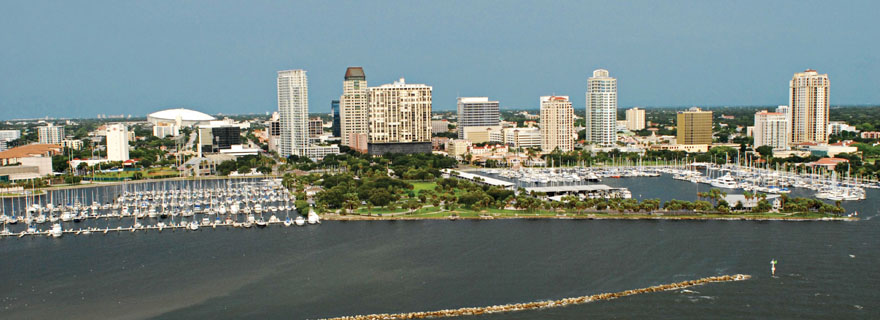
Economic Development Department.
St. Petersburg’s 7.5-mile waterfront stretches from Coffee Pot Bayou south to Lassing Park.
High-profile amenities like the pier capture more headlines but the most important legacy in St. Petersburg’s downtown waterfront master plan may be the city’s focus on stewardship of the waterfront environment.
“Every meeting we’ve had, stewardship has been a critical concern for residents,” notes Derek Kilborn, the city’s manager for urban planning and historic preservation. “There’s a lot of focus on water quality and what we can do to keep improving it.”
In fact the top priorities identified by residents and planners alike is environmental stewardship and enhancing the waterfront experience, Kilborn said. Residents will be asked for further input on the plans in a series of presentations and informal meetings scheduled for Jan. 26 to 29 at the University of South Florida’s St. Petersburg campus (learn more at stpete.org/downtown_waterfront_master_plan/) with more formal plans to be completed later this year.
Along with eye-catching designs for piers and parks, the city is looking at separate initiatives that enhance water quality, minimize floating litter, offer more spots to launch canoes or kayaks and provide safe fishing. Over the long term, city officials are considering ways to treat all stormwater before it enters the bay, living breakwaters that protect the waterfront from wave energy and shoreline erosion, and replacing impervious areas — particularly parking lots — with natural areas that filter stormwater.
The city’s 7.5-mile waterfront stretches from historic waterfront homes bordering Coffee Pot Bayou through St. Petersburg’s fast-growing downtown entertainment district. It continues south through a deep-water seaport, a regional airport that handles nearly 100,000 operations per year, and a working waterfront that attracts customers from around the world. It ends at laid-back Lassing Park, bordering the bay at the edge of the Old Southeast neighborhood.
Unlike the gulf-front beaches, most of the bayfront is easily accessible by car or on foot — an amenity which was mostly planned but partially serendipity, said Kilborn, a long-time St. Petersburg resident and history buff. Parts of the waterfront were purchased at the urging of W.L. Straub, then editor of the St. Petersburg Times who pushed a $1.3 million bond to keep the land open for public use.
Other sections, including the port and airport, were created with dredge-and-fill operations and large parts of the waterfront actually built up over time and became the open green space that makes St. Pete’s waterfront so unique.
Like all of Tampa Bay, water quality near downtown St. Petersburg has improved dramatically over the past 25 years, notes Michael Connors, public works administrator. A stormwater utility created in the early 1990s has invested millions of dollars in projects that prevent flooding; and two lakes in the downtown watershed — Mirror and Maggiore — have been outfitted with alum treatment plants that remove nutrients from stormwater. Lake Maggiore, which drains to Salt Creek and then to Bayboro Harbor, also has been dredged to remove 1.4 million tons of nutrient-rich sediment.
Along with the public investment, St. Petersburg has stringent stormwater regulations that require all new construction over 3,000 square feet to meet current stormwater standards, not the more typical redevelopment standards. “It’s even stricter than Swiftmud (Southwest Florida Water Management District) but has a fee-in-lieu option that helps fund regional stormwater improvements,” Connors said.
“It’s very rewarding to be part of a community that really is concerned about the environment and the quality of life that we see in St. Petersburg,” he said.
[su_note note_color=”#4094ad” text_color=”#ffffff”]
Community Themes
Meetings with the public and stakeholders, as well as walking tours that brought city officials and neighborhood residents together, helped identify the top five community themes for the downtown waterfront master plan.
- Stewardship of the waterfront environment
- Enhancing the experience of the water
- An active waterfront parks system
- Vibrant downtown places along the water
- A connected accessible downtown and waterfront
